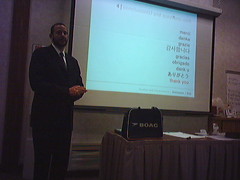…the rule set above is a mechanism for the intellectual process of intentional creation. It is much more than just imagination, or invention, or creativity, or project planning, though all of these are a part of it.
-
Everyware
 More from New Challenges… On Saturday night a sub-group — emboldened by a smuggled bottle of wine — sketched out a new manifesto for information architecture. Outward looking, devoid of definitions, accessible to the common person. On Sunday Mr. Greenfield parachutes in to advocate for what could be the impetus to the manifestis’ work: Everyware, a vision of ubiquitous computing with a set of principles guiding and urging designers to create responsibly the electronics of every place. Adam’s in-person plea created a sense of urgency for most of us to consider how to connect our skills with devices not yet invented, that we should invent. It was the perfect compliment to Dan Brown’s questioning of human vs. technology control of content.
More from New Challenges… On Saturday night a sub-group — emboldened by a smuggled bottle of wine — sketched out a new manifesto for information architecture. Outward looking, devoid of definitions, accessible to the common person. On Sunday Mr. Greenfield parachutes in to advocate for what could be the impetus to the manifestis’ work: Everyware, a vision of ubiquitous computing with a set of principles guiding and urging designers to create responsibly the electronics of every place. Adam’s in-person plea created a sense of urgency for most of us to consider how to connect our skills with devices not yet invented, that we should invent. It was the perfect compliment to Dan Brown’s questioning of human vs. technology control of content. -
Teaching design to enterprise architects
 More from New Challenges… James Melzer has made impressive progress on expanding the Zachman model to accommodate design (i.e. user experience) activities, vital to his challenge to educate and work with enterprise architects in U.S. Federal agencies.
More from New Challenges… James Melzer has made impressive progress on expanding the Zachman model to accommodate design (i.e. user experience) activities, vital to his challenge to educate and work with enterprise architects in U.S. Federal agencies. -
Philosophical underpinnings of system design
More from New Challenges… Dan Brown leverages Lakoff’s ideas on the central and exceptional elements of concepts in categorization to question how we design computer systems. We’ve built a lot of exception handling into systems to the point where we take some actions for granted, where computers are enforcing rules that perhaps people should (or shouldn’t).
He ends by asking if we should go back to how we understand businesses and design applications that follow that understanding. “…alternate conceptions of business may lead to other foundations for content management. What if business is a factory? A family? An army? A conversation?”
-
Designers and cultural influence
I’m at the New Challenges retreat in upstate New York this weekend. Whereas the last retreat was unexpectedly diverse by background, this one has attracted a geographically diverse audience, both ex-pats living on the East coast as well as visitors from Europe. Pouring rain is expected all weekend, so I expect folks to hunker down into a long stream of conversations.

So far there’s been a lot of explicit mention of organizational culture in the presentations, influenced by everything from translation to business process change. Talking through the MIG “trailmarker” model has resonated with folks who are seeing the bigger ramifications of product and process work. A longer explanation can be found in Design [is not a] Strategy. -
CMU design management reading list
Someone published a list on Amazon covering the reading list from Carnegie Mellon’s graduate Design Management class.
-
Gross National Happiness
Perhaps a better framing of the Index of Sustainable Economic Welfare (ISEW) is GNH: Gross National Happiness. Jigme Singye Wangchuck, king of the Himalayan nation of Bhutan, says GNH consists of “economic self-reliance, a pristine environment, the preservation and promotion of Bhutan’s culture, and good governance in the form of a democracy.”
On a related note, I just returned from Italy where the Slow Food movement has morphed into Slow Cities, an emphasis on local sourcing and less harried lifestyle. Spreading to other parts of Europe, the media reported the conflict between the desire for slower cities and the perceived need to compete with countries like China and India.
The Economist reassures us that manufacturing jobs shifting to the east is natural, and that those are actually less safe, less desirable jobs. The “rich nations” will provide more services, which are difficult to export. And…
People always resist change, yet sustained growth relies on a continuous shift in resources to more efficient use. In 1820, for example, 70% of American workers were in agriculture; today 2% are. If all those workers had remained tilling the land, America would now be a lot poorer.
-
Better management at younger, more competitive, freer companies
Management Practices across Firms & Nations is a survey of management practices in over 700 firms in France, Germany, the UK and the US with interesting results and implications for innovation capabilities…
…We also find a surprisingly large dispersion of management practices across firms with a long ‘tail’ of poorly managed firms. This presents a dilemma – why do so many firms continue to exist while apparently deploying inferior management practices? Our analysis suggests that this is due, in part, to a combination of: (i) competition, with tougher product market competition fostering better management practices; (ii) firm age, with younger market entrants utilising better management techniques; and (iii) regulation, with stronger labour market regulation apparently inhibiting the deployment of best practice management.
-
Designing a new New Orleans
“Just as it was important that Broadway not remain in the dark after Sept. 11, it’s important that we start thinking about the future despite all the very depressing news around us.” — Bill Hines, managing partner of a New Orleans law firm, on plans to revive parts of that city quickly.
 New Orleans was founded in 1718, specifically in the Autumn. The following Spring and Summer the French settlers realized their high ground was not high enough to avoid flooding, and so the building of levees began. That building — eventually assumed by the Army Corp of Engineers — has continued ever since. Some say it “set off an environmental chain reaction that helped destroy the natural barrier protecting New Orleans from catastrophic storms.”
New Orleans was founded in 1718, specifically in the Autumn. The following Spring and Summer the French settlers realized their high ground was not high enough to avoid flooding, and so the building of levees began. That building — eventually assumed by the Army Corp of Engineers — has continued ever since. Some say it “set off an environmental chain reaction that helped destroy the natural barrier protecting New Orleans from catastrophic storms.”In the emotion surrounding the World Trade Center planning, we suffered a failure of imagination. The symbolic importance of the location made new architecture a political time bomb.
Without the emotional weight of terrorism, the planning in New Orleans doesn’t have to be this way. Imaginations already bear the fruit of honest thinking: Make It an Island, Raise the Ground, Restore the Marsh, and Build Diversity. These are the kind of bold ideas we need if billions are to be spent rebuilding New Orleans, but they need to balance with the human needs and emotions of the people who live and work there.
And if we really use our imaginations, we will realize that not rebuilding is also a viable option.
-
Mondo list of idea generation techniques
http://www.ideagenerationmethods.com/
The methods have been drawn not just from the worlds of creative problem solving and innovation, but also from other worlds such as organisational change, strategic planning, psychotherapy, the new sciences and the creative arts.
-
Your personal connection to Katrina
Lou linked to an inspiring report of Alan Gutierrez’s wiki set up in the wake of hurricane Katrina…
When I awoke, I found that the Xavier families, has simply kept the Wiki page going without me. I cleaned up the their markup, buth the information is there.
Now, I’m finding the page gets updated, nice and neat.
Wiki works.
I received a request by more pedestrian means — email — from old university friend Shel who safely fled New Orleans for Florida but who must now settle anew sans possessions. Her list of things needed made it easy for me to provide specific help to someone I care about, lifting me (selfishly, I know) out of a feeling of uselessness here in NYC.
And I started to think how others might do the same. Who do we know, or who is in our network, that was affected? How can we find out? We have tools now. Social network software like LinkedIn lets you search by number of degrees from you and zip code (here’s FEMA’s list of aid-eligible areas, New Orleans is 70112).
-
Madelon Evers on learning from design
I added another quote — notably from a woman — to the Design Thinking and Business page, courtesy of Madelon Evers… “…To achieve superior design thinking in business, we need to facilitate learning from design across organisations.”
-
Gladwell on why focus groups suck
Malcolm Gladwell recently gave the keynote at the American Association of Advertising Agencies’ Account Planning conference in Chicago. It’s excerpted on Advertising Age ($). If you’ve worked in design or product development (or read “Blink”) you know the drawbacks of focus groups. But what Gladwell does here is describe the solutions as ones of management. Not surprisingly, I agree.
Here’s the ending…
Now think about the Aeron chair. [The focus group participants] say they don’t like the chair, of course they don’t. The chair is nothing they’ve ever seen before, but that was the whole plan in designing the chair. But that’s what’s wonderful about it, that’s why this chair will make billions of dollars for Herman Miller, but it’s also what dooms that chair in the focus group, because people don’t have the language.
Market research, when it is observational or when it is interpretative, is profoundly useful. But those are two critical things. They require the intervention of the person conducting the research. They require the findings that are gathered are considered, and thought about, and processed and interpreted. Back in the 1950s, most of the major advertising agencies on Madison Avenue employed Freudian psychoanalysts for this precise reason, and you don’t see that anymore. I think that’s a big mistake.
This understanding about what’s so terrible about focus groups ought to pave the way that we manage people. First and foremost, it’s very important for management to trust the creative talent.
The second thing is patience. The more breakthrough, the more revolutionary and the more innovative an idea is, the longer it will take for people to come to appreciate it.
The third thing is it requires people in management to tolerate uncertainty. The thing that’s driving all this focus-group and market-research data is the desire of people with the management power to make every decision as methodical and thought out and certain as possible.
-
Decision design
Two recent thoughts on designing decisions, one good semantic point from my partner John in the RSA Journal…
John Zapolski, a San Francisco-based principal of the Management Innovation Group, believes there is “increasing importance in using design as a framework for organising decisions that people makeâ€, citing, alongside the work of his own company, that of innovation consulting group IDEO. He is keen to differentiate designers from design, implying that the people who use these methods may not be called designers.
And another general observation in BusinessWeek from Roger Martin of the Rotman School of Management…
If decision production is such a big deal, corporations should be paying very close attention to design of decisions — as much or more attention than they pay to product or service design. In my experience, they aren’t. Corporate decision factories feature extremely low-quality decision design.
-
A culture like good improv
We hosted an informal discussion on innovation the other day, and lucky for us Harry Max attended. Harry is good, and I don’t employ those italics lightly. He talked about those elusive aspects of a culture that nourish innovation, that are mirrored in improv…
- Trust
- Listening & self-awareness
- Accepting and making offers (Yes, and…)
- Moving into action with full commitment
- Staying nimble
Niti was kind enough to blog more about his talk.
Purely coincidentally, I’ve been exploring the improv culture in my neighborhood. If you’re in NYC, $8 can buy you this experience at The PIT or the Upright Citizens Brigade Theater.
